
Welcome to CivilGEO Knowledge Base
Welcome to CivilGEO Knowledge Base

Welcome to CivilGEO Knowledge Base
Welcome to CivilGEO Knowledge Base
The Subbasin Table Edit command allows the user to edit the subbasin parameters in one dialog box for common hydrology infiltration and runoff methods. When the user selects this command, a modeless dialog box will be displayed. This dialog box contains an editable data grid listing all the subbasins in the current scenario. When the user selects a row in the data grid, the corresponding subbasin will be zoomed to the Map View (if not visible) and highlighted. In addition, the user can select a subbasin from the Map View, and the corresponding row in the data grid will be shown selected.
Follow the steps below to use the Subbasin Table Edit command:
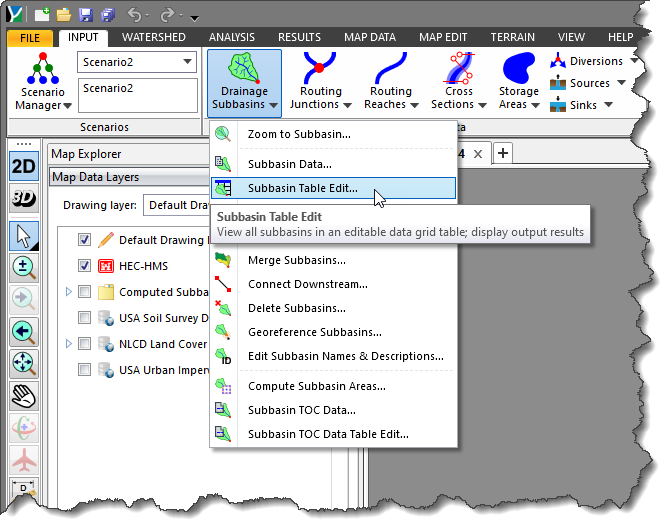
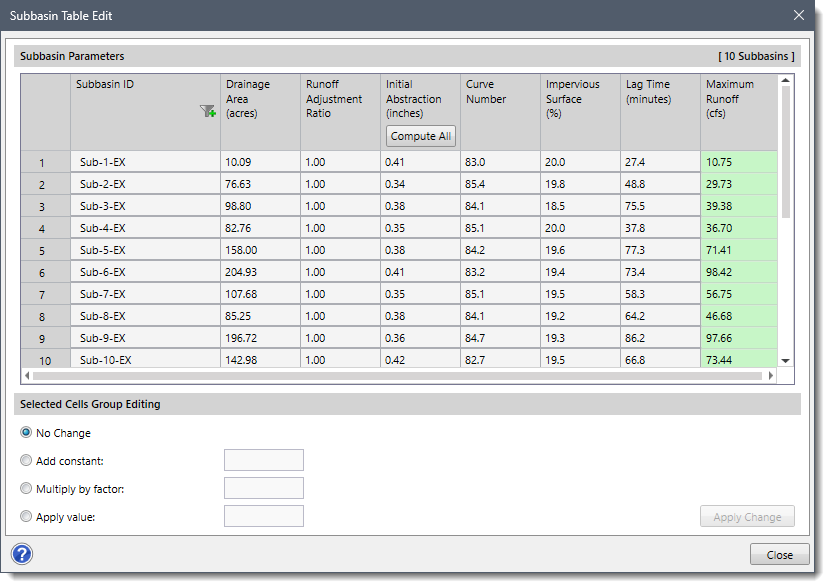
The following sections describe how to use the Subbasin Table Edit command and interact with the above dialog box.
The Subbasin Parameters section will display the editable data grid columns listing the subbasin parameters contained in the current scenario. Based upon the selected hydrology infiltration and runoff methods in the Project Options backstage page, as shown below, the data grid columns listing will be changed.
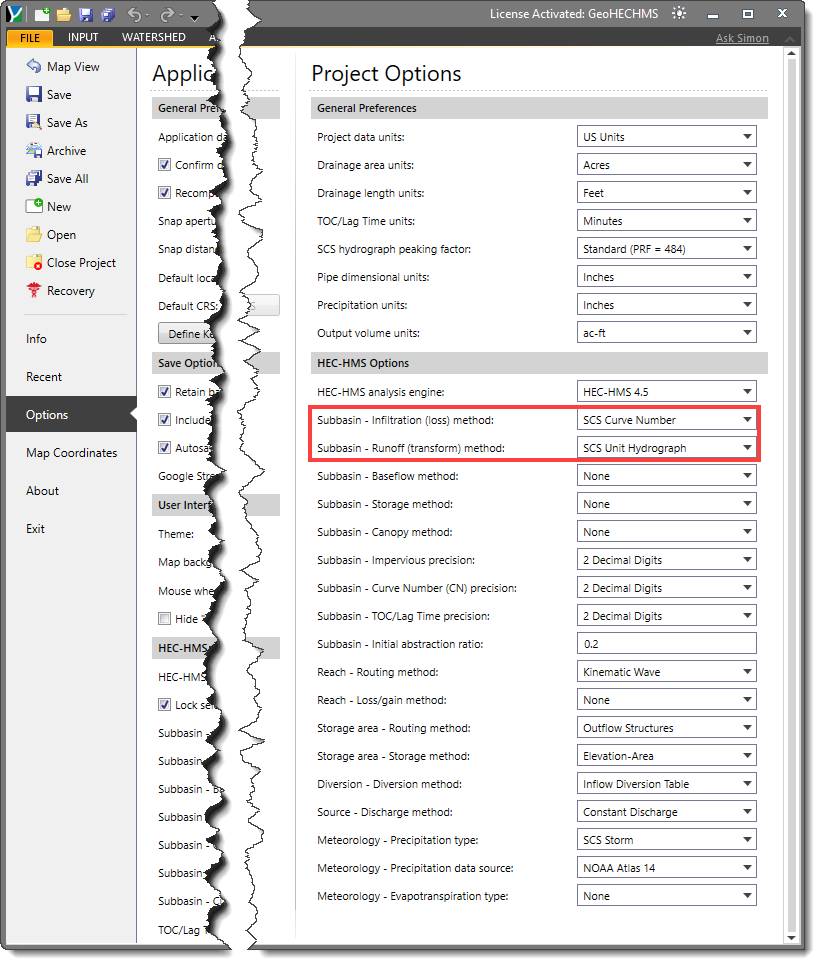
In general terms, the following column sections will be listed in the data grid:
Note that only the hydrology infiltration and runoff methods selected in the Project Options backstage page will be listed in the data grid if they correspond to the common hydrology infiltration and runoff methods listed below.
The user can select the following infiltration methods from the Project Options backstage page and the associated parameters will be listed in the data grid of the Subbasin Table Edit command:
| Method Name | Data Grid Column Name |
|---|---|
| SCS Curve Number | |
| Green & Ampt | |
| Initial & Constant |
The user can select the following runoff methods from the Project Options backstage page and the associated parameters will be listed in the data grid of the Subbasin Table Edit command:
| Method Name | Data Grid Column Name |
|---|---|
| SCS Unit Hydrograph | |
| Clark Unit Hydrograph | |
| Snyder Unit Hydrograph |
The user can export the data grid column values to Microsoft Excel or PDF documents. To export data into Excel or PDF, right-click in the data grid column and select Export Table to Excel or Export Table to PDF command from the displayed context menu.
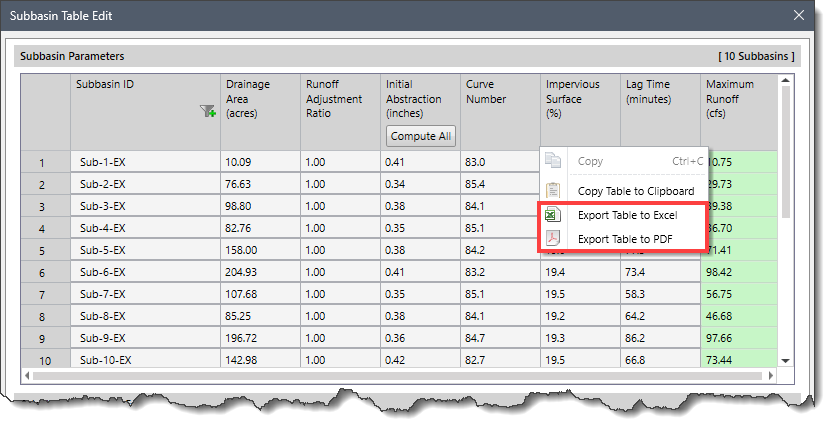
The user can send the data grid column values to the Windows clipboard. Moving a data grid column value to the clipboard allows those values to be pasted into another software application. To transfer the data to the Windows clipboard, right-click in the data grid column and select the Copy Table to Clipboard command from the displayed context menu. The data will automatically be sent to the Windows clipboard.
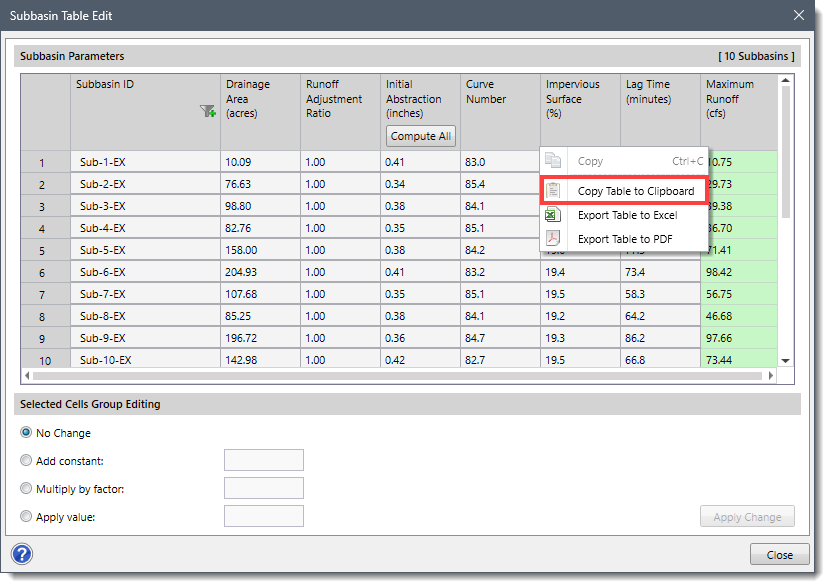
After editing the desired subbasin parameters for common hydrology infiltration and runoff methods, the user can click the [Close] button to close the dialog box.
The Selected Cells Group Editing section allows the user to edit multiple cells in the Subbasin Parameters editable data grid at once.
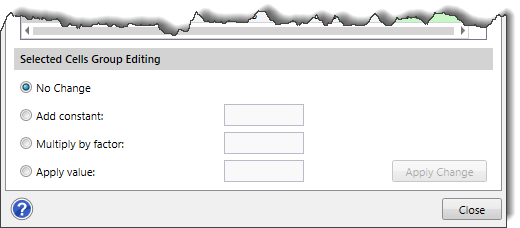
The user can select the desired cells from the editable data grid and then edit the subbasin parameters using one of the following options:
After selecting the preferred option, click on the [Apply Change] button to update the new values in the cells.
 1-800-301-02-955
1-800-301-02-955
 608-729-5100
608-729-5100
(US and Canada)
 [email protected]
[email protected]
 +1 608-729-5100
+1 608-729-5100
CivilGEO India
Graphix Tower, A-13 A
3rd Floor, Sector 62
Noida, Uttar Pradesh 201309
IndiaTel:
1-800-301-02-955 or
+91 022-3831-8601
CivilGEO United States
8383 Greenway Blvd
6th Floor
Middleton, WI 53562
USATel:
608-729-5100 or
800-488-4110
Copyright © CivilGEO, Inc. All rights reserved. The CivilGEO logo, “GeoSTORM”, “GeoHECHMS”, “GeoHECRAS”, and “Ready To Engineer” are registered trademarks of CivilGEO,Inc.
All other brands, company names, product names or trademarks belong to their respective holders.
We use cookies to give you the best online experience. By agreeing you accept the use of cookies in accordance with our cookie policy.
When you visit any web site, it may store or retrieve information on your browser, mostly in the form of cookies. Control your personal Cookie Services here.
The ZoomInfo WebSights snippet drops three cookies to track Unique Visits:
1. _pxhd - Related to the Perimeter X security layer (Perimeter X isused to prevent bot attacks).
2. _cfduid - Related to the CloudFlare security layer (CloudFlare is the Network Security protocol that ZoomInfo uses to orchestrate the rate limiting rules).
3. visitorId - This is how WebSights identifies recurring visitors








